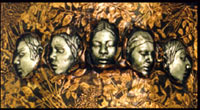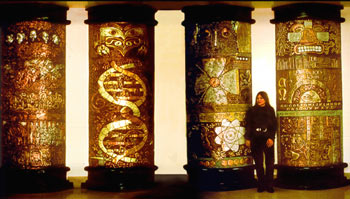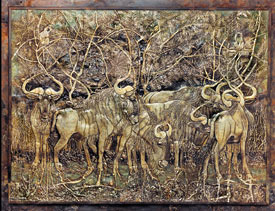Copper Catalyst: Evelyn Rosenberg's Explosive Art of Detonography
You would never guess that Detonography, the most explosive form of art known to man, was created by a soft-spoken artist named Evelyn Rosenberg. This New Mexico-based artist has ignited a technique of mixing explosives and copper to create a unique collection of artwork that has earned her universal recognition in the contemporary art world.
 History Pillar Detail, Pillars of Knowledge
History Pillar Detail, Pillars of Knowledge Photographs courtesy of Evelyn Rosenburg
 Biology Pillar Detail, Pillars of Knowledge
Biology Pillar Detail, Pillars of KnowledgeThe act of Detonography, a technique and term created by Rosenberg in 1985, serves as a technical conceptualization of philosophical ideas that inspire her work. Using thin, 3' by 8' sheets of commercial copper purchased from Bralco Metals of Albuquerque, Rosenberg detonates a sheet of plastic explosive over a sandwich of a carved image and a metal plate, forcing the metal plate onto the carved image, to create a beautiful bas relief she calls a detonograph.
"I also use brass and stainless steel, but the copper takes the most intricate designs," she explains. "In every project I like to try something new which I have not tried before. For instance, someone told me about a new copper that is very pure (101) that may give me a deeper relief. I would like to try that. I also keep experimenting with new patinas and colors. I would love to get a really good red and purple that would be more permanent and do more with plasma spraying, a way of spraying liquid metals onto base materials. All of these things need to be investigated and that is what keeps things interesting."
When creating a work of Detonography, Rosenberg considers the area, community and location of the sculpture, and incorporates this feeling into her work. She has created more than 40 public Detonography sculptures in the past 10 years for institutions of various kinds around the country.
"Creation, dissolution, the earth, universe and relationship between human beings and the natural world have always been the major focus of my work," explains Rosenberg. "I mirror these interests in the way that I create the sculpture-by forming, etching and welding within the blast itself. I've built up rich textured surfaces, almost like giant jewelry, as well as incorporating fabricated metal within my work to create more three-dimensional freestanding sculptures. I also work with architects and planners to create fully realized environments where the sculptures live and interact with the views. Fabricated metal is incorporated into my work to create more three-dimensional free standing environments in which the sculptures live and interact with their audiences."
Rosenberg's career has spanned several decades, garnering the attention of galleries, museums, various media stations, and private customers who commission her to create one-of-a-kind pieces for their homes or offices. Each piece possesses a unique look that can only be obtained by using explosives. Rosenberg has appeared on "Ripley's Believe It or Not", "Nightline", "Smithsonian World", "CBS Nightly News", "The Today Show", "ABC News with Peter Jennings", "Home Show", "All Things Considered" and many more, including countless magazines, newspapers and radio stations.
The Journey of Detonography
Although Rosenberg coined the technique Detonography in 1985 when she was searching for a new art medium, her journey began many years ago, when Rosenberg's husband, Dr. Gary Rosenberg was drafted. Born in Washington, D.C., she found herself in New Mexico when Dr. Rosenberg, just out of medical school, was sent to Sandia Base, located not far from Kirtland Air Force Base, near the city of Albuquerque.
Evelyn attended graduate school and received her master's degree in Fine Arts at the University of New Mexico in printmaking. After the army, they moved to Israel where Evelyn taught at Haifa University in the art Department, and her career blossomed, taking her on an amazing journey from Kibbutz College, Upper Galilee, Israel and Bombay, India to Montclair State College, New York and London. During the days when she founded Detonography, she was owner and operator of Eber Press, a printing studio, and later adjunct professor of Fine Arts at New Mexico Tech, from 1985 to 1988.
"I was teaching printmaking, painting and drawing in Israel, but we came back to New York and my husband did his residency at Einstein School of Medicine in the Bronx," she recalls. "While he was doing his residency, I taught at Montclair State College. After three years of finishing his residency and living in a loft in Soho, we decided to return to New Mexico where he began working at the University of New Mexico Medical School and is now Chairman of Neurology. I had received a grant from the National Endowment of the Arts and painted murals in schools for two years. I enjoyed large mural projects, which got me interested in huge public art. That had been my first exposure to large public art."
Rosenberg met Gidion Sivan, an Israeli explosive expert who was in the United States on sabbatical at the New Mexico Institute of Mining and Technology. Sivan, according to Rosenberg, wanted to do something fun and had a brilliant idea that art could be created by using explosives. He was searching for an artist to work with and someone suggested Rosenberg, who was doing etchings at that time. They met, realized they had a common goal and, to make it easier, both spoke Hebrew. At that time her copper plates for the etchings, were becoming deeper and deeper embossed.
 Evelyn Rosenberg with her Pillars of Knowledge, Rockville, Maryland, 1989
Evelyn Rosenberg with her Pillars of Knowledge, Rockville, Maryland, 1989Photograph courtesy of Evelyn Rosenberg
"I was using large vats of acid because I was making door-size prints, but it was becoming dangerous because of the acid," she explains, noting she had been searching for an alternative way to create the same prints. "Gideon and I experimented at the 'Center of Explosive Technology' at New Mexico Tech, and began working together, fusing both of our ideas-It was fantastic. After three months, he returned to Israel, but I continued to work on this medium. I worked with the Energetic Materials Research and Testing Center at the New Mexico Institute of Mining and Technology in Socorro, New Mexico. Soon, the idea of trying to make printing plates were given up and I started making bas-relief metal plates that would stand on their own as works of art. I always say it's like childbirth-messy, dangerous, an uncontrollable force, but then you get something beautiful, delicate and refined from it. That's how I started doing it."
Since then, Evelyn has created about 40 to 45 pieces of public art throughout the United States as well as one in Tanzania at the Serengeti Game Park Visitors Center entitled Regenesis. Some of her commissions include Kaleidoscope, an inside and outside wall piece, in Sarasota, Florida, Metamorphosis, at the University of New Mexico, in Roswell, New Jersey, Gaia Genesis at the Sonora Desert Museum, in Tucson, Arizona, Roots at the Nebraska State House, in Lincoln, Nebraska, Pillars of Knowledge at Watkins Mill High School, Montgomery County Maryland, Scale of Justice, a 36-foot kinetic fountain at Courthouse Plaza, in Albuquerque, New Mexico, and many, many more.
She also completed a memorial for Senator Paul Wellstone and his wife, Sheila, from St. Paul, Minnesota, who were killed in a plane crash called We the People, located in the lobby of Neighborhood House, an immigration center in St. Paul.
Rosenberg's Explosive Process of Detonography
Rosenberg's Detonography always starts with an idea, a sketch and, for some creations, a constructed model to make sure the pieces join together perfectly. The final design is transferred to plaster mold, resulting in bas-relief images, which are transported to the test range for forming."Then, it's placed on the ground, covered with a thin metal plate and the materials that will be impressed into the Detonograph are arranged on the plate and covered with the explosive sandwich," she explains. "I sometimes include natural objects like feathers, leaves or pieces of fur placed between the sandwich and the mold to add interest and provide me with freedom to create art unparalleled in its beauty and versatility. When it's all together, the explosive is detonated and the actual explosion forces the images of the objects that include the contours of the mold into the plate."
 Regenesis, Serengeti National Park VIsitor's Center, Africa
Regenesis, Serengeti National Park VIsitor's Center, AfricaPhotograph courtesy of Evelyn Rosenberg
After the dust settles, Rosenberg inspects the results. If it's the way she planned, she polishes it and treats it with chemicals to created colorful patinas in a variety of colors. Details are polished in, just like a painting, from the explosively created panel. She takes advantage of three characteristics that occur in the blast to create her images. First, the metal is formed over a plaster mold of three-dimensional design by the tremendous pressure of the explosive, which is traveling at 27,000 feet per second. Second, due to the force of the explosion, dissimilar metals are pressure welded together by the pressure of the blast and third, real objects (as stated above) are placed between the explosive and the metal plate to impress them into the surface of the plate.
Rosenberg has been the recipient of many awards, grants, and residencies for her Detonography work, including the Banff Center for the Arts Residence, Banff, Canada, the Ragdale Colony Residence, Lake Forest, Illinois, an Award of Merit from the Albuquerque Conservation Society for the best public art in the city, and New Horizons Prize for contribution to the arts, International Society of Arts, Science and Technology, Leonardo Magazine. She was recently presented with the Governor's Award, New Mexico's Most Prestigious Artistic Honor, last May by Governor Bill Richardson and First Lady Barbara Richardson.
"This new medium still fascinates me," she says. "People don't realize when staring at it that it was exploded because of its controlled effect. I enjoy taking a destructive force and using it to make something that I feel is beautiful."
Resources:
Also in this Issue:
- Copper Catalyst: Evelyn Rosenberg's Explosive Art of Detonography
- Val Bertoia: Alloy and Metaphor
- Mark Oberkirsch and the Art of Copper Repoussé
- Carnegie Museum of Natural History Reopens Hillman Hall of Minerals and Gems
- Ellis Island Restoration Gives New Life to Ferry Building's Cupola Sculpture
